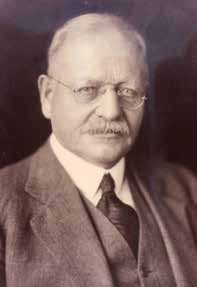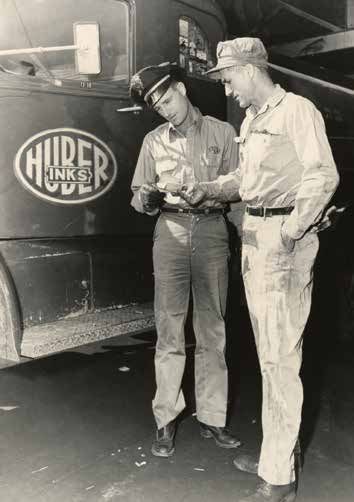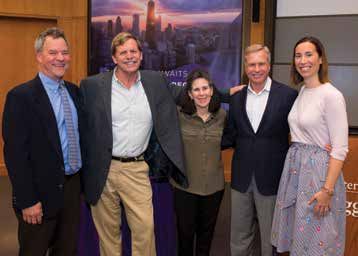Decisions at the J.M. Huber Corporation are made with the long view in mind: How should the business evolve so it can succeed for another 136 years? How can a family with hundreds of members sustain its ownership of a $2.3 billion manufacturing company with operations in 20 countries? And how can the company use the natural resources required to make its products in a sustainable way?
“One of the things that our family does really well is that we never stop evaluating our processes,” says Molly Heaney, 39, a fifth-generation family member who is a voting member of the Huber corporate board, serves on the family's education and development committee and formerly served on the family council board. “There's no complacency. Families are dynamic and need to change.”
 Founder Joseph Maria Huber started the business after immigrating to New York from Germany in 1883. As the company grew from a single plant making pigment for ink in Brooklyn, N.Y., to an Edison, N.J.-based manufacturing company with 4,200 employees worldwide, the family also expanded. The current 242-member family encompasses the third through sixth generations.
Founder Joseph Maria Huber started the business after immigrating to New York from Germany in 1883. As the company grew from a single plant making pigment for ink in Brooklyn, N.Y., to an Edison, N.J.-based manufacturing company with 4,200 employees worldwide, the family also expanded. The current 242-member family encompasses the third through sixth generations.
Today, the Huber Corporation is a portfolio company that owns CP Kelco, which produces nature-based ingredients such as pectin and xanthan gum for consumer and industrial applications; Huber Engineered Materials, which makes specialty ingredients for industrial, agricultural and consumer applications; Huber Engineered Woods, which manufactures high-performance roof, wall and flooring products; and Huber Resources Corp., which offers sustainable, value-added forest management.
The company is owned almost entirely by family members, with no one individual or branch controlling a majority of the company. Only two family members currently work at the company, and the top executives are non-family members. The size of the family — along with the complex nature of the business — adds to the challenge of keeping the family engaged.
“It has never been a family business that's easy to explain,” says Guy Cecala, 66, a fourth-generation Huber by marriage who has been active in family governance. “We don't make widgets.”
The growth of the family and the business has led to highly developed governance systems on the corporate side and the family side. All along, the company's decisions have been guided by the Huber Principles: environmental, health and safety sustainability; ethical behavior; respect for people; and excellence.
“The one constant and guidepost has been the Principles,” says Martha Huber, 64, a fourth-generation family member by marriage who is co-chair of the family nominating and evaluation committee and a former Huber corporate board member. The Principles were formally unveiled in 1987, though their roots go back to the company's founding. “They really are fundamental, both for the Huber family and for the people at the company. It's how we judge our success.”
A strong governance system
With members of the fifth generation taking on leadership positions in both corporate and family governance — and the sixth generation growing — the Huber family will reach “the distant cousin enterprise stage” within a few decades, notes Perry Premdas, an independent director on the Huber corporate board who is in charge of shareholder relations. Premdas is a retired CFO of a global chemical company.
 Today's corporate and family governance systems have their roots in the 1980s, when the son of the chairman at the time told him that the rising generation didn't know much about the business they would inherit one day. The third-generation members who were then running the company took the matter seriously. They began work on a family education curriculum, including a director training program, and in 1986, fourth-generation family members Peter Francis, 67, and Martha Huber were among the first non-voting family directors. The family also began working with outside advisers, including John Ward of Northwestern University's Kellogg School of Management.
Today's corporate and family governance systems have their roots in the 1980s, when the son of the chairman at the time told him that the rising generation didn't know much about the business they would inherit one day. The third-generation members who were then running the company took the matter seriously. They began work on a family education curriculum, including a director training program, and in 1986, fourth-generation family members Peter Francis, 67, and Martha Huber were among the first non-voting family directors. The family also began working with outside advisers, including John Ward of Northwestern University's Kellogg School of Management.
During the 1990s, three fourth-generation members became voting directors on the Huber board: Francis, who had completed an MBA from Stanford University's Graduate School of Business and had purchased a company in Seattle; Martha Huber, who had also recently earned an MBA; and Peter S. Brock. The board also added independent directors.
Francis joined the board's governance committee and then became the committee chair. Right after he took on the role of chair, he had to create a process for selecting the next CEO. Huber's sitting CEO, the first non-family member to hold the position, had announced his intention to retire within five years.
By that time, Francis was living in Seattle and running his business in addition to his work on the Huber board. But the trajectory of his career changed in late 1991 when, during the CEO search, the executive chairman of the board — Francis' uncle — died suddenly. Another uncle, who had previously served as chairman, president and CEO, stepped back into the role of chairman and encouraged Francis to compete for the CEO post.
“I had an interesting decision to make: Would I pull up stakes and leave my company and home in Seattle and compete for a job for which there was no certainty of getting selected?” Francis says. “I had a real interest in manufacturing, and Huber was a much bigger company, so I could have a bigger impact.”
So for two years he commuted from the West Coast to the East every week, working for the soon-to-retire CEO as vice chairman of the board.
In April 1993, Francis became chairman of the board — and immediately confronted a crisis. A global electronics business that made up a large portion of Huber's revenue had experienced significant losses. One of the outside directors asked Francis to focus on fixing the problem.
Working with a member of the finance team — while still a candidate for the CEO position — he identified that the critical issue was one of control rather than a market problem. He cut costs and shut some facilities to return the operation to profitability.
“That gave some confidence to board members that I knew what I was doing tactically,” Francis says. “I was younger than the other candidates, and my experience was different and somewhat unorthodox.”
One step in the CEO selection process was for each candidate to write a description of where they would take the company. Francis put a lot of work into his vision, even hiring a consulting firm to do some analytical work for him.
“The company had never sold any whole businesses,” Francis says. “I felt we needed to make changes. I said so and gave the reasons why — and ultimately the board made me CEO.” He became president and CEO on Jan. 1, 1994, in addition to his role as chair.
During his 15-year tenure as CEO, Francis led a transformation of the company. Huber sold 30 assets and acquired 120. The board shifted from having some independent directors to a having a majority of directors from outside the family.
Francis “really was a change agent,” says Martha Huber.
Francis also led Huber to adopt the portfolio management company structure. The three largest of the portfolio companies now have their own boards, which focus on business strategy. The Huber board, which evolved along with the company, now focuses on the portfolio strategy and how the company allocates resources among the businesses.
 “The company had diversified from ink into some of the natural resources associated with production of ink, many of which were capital-intensive, commodity businesses,” Martha Huber says. “There was a real effort to look at how to position ourselves for continued long-term success.”
“The company had diversified from ink into some of the natural resources associated with production of ink, many of which were capital-intensive, commodity businesses,” Martha Huber says. “There was a real effort to look at how to position ourselves for continued long-term success.”
In addition to being majority-independent, the Huber board now has three voting family directors and two non-voting family directors. Each of the three portfolio company boards has slots for one voting and one non-voting family director.
“We value the independent voice and perspective of our board, and we have a phenomenal group of independent directors,” Heaney says. “But if you're a family business, it's important to have a family voice.”
Heaney calls the non-voting director positions “an unbelievable opportunity” for family members to learn about the business. It's also a good way to see which family members could become good voting directors.
Before Francis left his role in 2009, he gave the board five years' notice of his retirement. He also gave up the chairman title 18 months before retiring, so he could work with the new non-executive chairman before he left. Mike Marberry, a non-family member who had been president of Huber Engineered Materials, was appointed president and CEO.
“Leaders have a tendency to stay too long, and I wasn't going to do that,” Francis says. “Organizations need change.”
Planning for the future
As the Huber family grew, they found they needed a stronger family governance structure, a realization common to later-generation business families. Family directors, who previously had represented each branch, now were selected based on their passion for governance. The transitions the company was undergoing also made it more important to have a formal process for communicating with the family and getting family input.
“Why does a five-generation family business decide it needs to overhaul its family governance system?” Cecala says. “One reason was the sheer number of family members. A lot of them felt disconnected from the company.”
Family governance gradually evolved into its current structure.
The Huber Family Council, composed of all family members ages 16 and older, elects the family council board and two other committees: the nominating and evaluation committee, which identifies and evaluates family members who want a role in corporate or family governance; and the education and development committee. The family also has other committees and establishes task forces as needed.
 The result is a multitude of opportunities for family members to get involved.
The result is a multitude of opportunities for family members to get involved.
For example, Heaney started hearing about family governance — “such a unique concept that as a child and teen I didn't really understand what it meant” — when her mother got involved in committee work. She joined her first family committee at her mother's suggestion, when she was in her mid-20s.
She joined the family council board in 2010 after having served on what was then called the family leadership and development committee.
Heaney also was a non-voting member on the corporate board and two of the portfolio company boards. In 2016, she was elected as a voting member of the corporate board. She is also the family communications adviser.
The family has created multiple ways for family members to engage, giving members of the younger generations a feeling of connection. One is the annual meeting, a family gathering that typically draws 80 to 100 people.
Evan Seely, 33, a fifth-generation family member who is co-chair of the family council board, grew up attending the meetings.
“I remember a meeting in Houston when the company was making products that went into the oil process,” Seely says. “We did a project with fish tanks, pebbles, Hershey's chocolate and ketchup that taught us about the layers of the earth and where you can find oil.”
Since the mid-1990s, executives have traveled to visit with family members outside of the annual meeting. In January 2018, 85 family members provided input during the six-session “Director Road Show,” which included stops in New England, Denver and Los Angeles.
In 2014, the company established a family ambassador program. Family members attend milestone celebrations at company facilities and briefly address the employees, reinforcing the Huber Principles.
“It cements the bonds both ways: Employees get to know the owners, and the owners, particularly the younger ones, gain an affiliation with the business,” Premdas says. Last year 20 ambassadors attended 16 events.
In addition to the non-voting board member positions, the family offers internships to family members. The two full-time employees who are Huber family members began their tenure as interns.
The family also recently created the Owners' Room, an in-person meeting that addresses topics from a shareholder's perspective. Unlike the Huber Family Council, where each family member gets one vote, Owners' Room votes are allocated by share.
The family council board also spearheads a number of ways for the family to communicate. One is the “NextGen Connection” newsletter, a 16-year-old quarterly publication featuring news from family members and the company.
The family and business have been honored for their governance, leadership and work at creating a sustainable business.
The National Association of Corporate Directors' New Jersey Chapter named Huber's board its Private Company Board of the Year for 2019. Also this year, Kennesaw State University's Cox Family Enterprise Center honored the company in the sustainable business category at the Georgia Family Business of the Year Awards. In 2018, Huber received the 2018 Kellogg Family Enterprise Leadership Award. In 2013, it received the IMD-Lombard Odier Global Family Business Award, and in 2011, Huber was named one of the World's Most Ethical Companies by the Ethisphere Institute.
In addition to sustaining the business and their connection to it, the family has focused on environmental sustainability.
“The shareholders want to make sure our employees are taken care of and that the company is not shortchanging any environmental or safety requirements or procedures,” Cecala says. “Just because you're digging in the ground or having some sort of manufacturing operations doesn't mean you can't treat your employees well and be stewards of the environment. That's what Huber has strived for and succeeded at.”
The changes started by the third generation and developed by the fourth generation are now being continued by the fifth.
“I felt — and still feel now — so much respect and appreciation for how the third generation responded to what was a very big change for them,” Martha Huber says. “They were really gracious and thoughtful about how they did it. They were living examples of the Huber Principles.”
Margaret Steen is a frequent contributor to Family Business Magazine. She last wrote about MacLean-Fogg Company.
Copyright 2019 by Family Business Magazine. This article may not be posted online or reproduced in any form, including photocopy, without permission from the publisher. For reprint information, contact bwenger@familybusinessmagazine.com.

